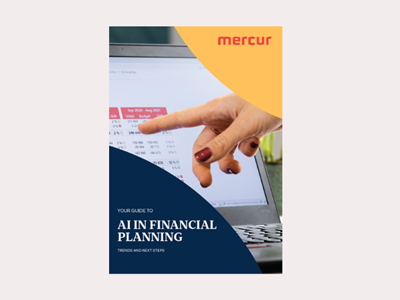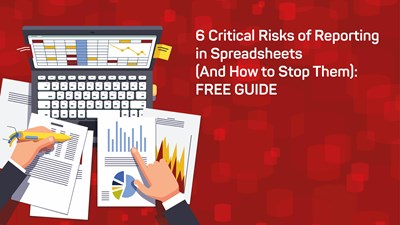
Top-Down vs Bottom-Up Budgeting: Which Budgeting Method Works Best
Many organisations can lose direction during major market shifts, which is why strategic financial planning is a critical part of the process. Budgeting aligns resources with strategic goals, and there are two primary approaches: top-down and bottom-up. These methods offer different perspectives on the same challenge, each with advantages and limitations that impact an organisation's financial health and alignment with strategy.
These approaches are essential tools for financial leaders aiming to drive business growth. The key is not to rely exclusively on one method, but to find the right balance that fits the organisation’s structure and objectives.
What Is Top-Down Budgeting?
This method begins at the executive level, where the senior management establishes financial targets based on given strategic objectives. Individual departments then receive budget allocations and are expected to plan within those limits.
The process typically involves leadership reviewing market conditions, competitor activity and past performance before setting company-wide goals. These targets are then translated into departmental budgets, with each team aligning its plans to the broader objectives.
Advantages of the Top-Down Approach
The primary strength of top-down budgeting lies in its strategic continuity. When executed properly, every pound spent improves the company's core objectives and prevents the development of conflicting priorities between departments.
Administrative simplicity means having one comprehensive budget prepared by the management. This requires fewer resources than coordinating multiple submissions from different departments. It's the easiest way to reduce potential coordination errors and administrative overhead.
Another significant benefit of this approach is time efficiency. Senior executives can establish budgets rapidly, enabling faster response to market opportunities or threats. This benefit proves to be particularly valuable in environments where delay may cost you a competitive advantage.
The top-down method uses centralised control and resource prioritisation. If there happens to be a financial oversight, it remains concentrated at the executive level. At the same time, leadership can allocate resources to strategic initiatives that may not emerge only from departmental planning.
Disadvantages and Limitations
Despite its many advantages, the top-down approach also has significant challenges. The biggest limitation is the disconnection between what the executives assume and the actual operational reality. Senior management may lack more in-depth knowledge of the department requirements, which can lead to unrealistic allocations.
This approach may also overlook the innovative opportunities that emerge at operational levels. It's not rare that frontline employees identify efficiency improvements or revenue opportunities that don't actually reach executive attention through the top-down budgeting processes.
Another disadvantage is that employee engagement often suffers when this method is used. Staff may feel less committed to achieving financial targets if they don't have input in the budget creation.
What Is Bottom-Up Budgeting?
This budgeting method reverses the traditional hierarchy. It begins with the departmental needs assessment and builds toward an all-inclusive organisational budget. Each department analyses its needs, projects costs and then submits a detailed proposal to the senior management.
It's an approach that uses the expertise of operational managers who understand day-to-day business realities. Some organisations prefer this method because they know that departments can create budgets that are based on actual requirements, historical data and anticipated challenges.
Advantages of the Bottom-Up Approach
Bottom-up budgeting pproach often results in higher accuracy, as departments build their budgets based on firsthand knowledge of operational needs. As a result, the financial forecasts are typically more realistic and better reflect actual requirements.
Another point that shows the strength of this approach is that employee engagement increases significantly when staff participate in budget development. The involvement will improve motivation and implement the success rates. How? Because resource allocation will become more precise when the departments specify exactly what they need to achieve their set goals. It's a great strategy to improve the return on investment and reduce waste.
The method also captures the valuable knowledge of those who have operational control. It helps frontline managers identify efficiency opportunities, revenue enhancement possibilities and cost-savings measures.
Challenges of the Bottom-Up Method
One of the biggest challenges of the bottom-up method is that it requires considerable time and coordination effort. It is administratively challenging to collect, review and consolidate the multiple submissions from the different departments.
Departments may sometimes prioritise local objectives over company-wide goals, which leads to fragmented resource allocation. Strategic misalignment is a serious threat because the departmental budgets might not support the broader strategic initiatives.
Sometimes, departments may overestimate requirements to secure additional resources. This results in unrealistic overall budgets that strain the organisational finances, which is why budget inflation is a common problem.
The Hybrid Approach: Finding the Perfect Balance
Modern organisations recognise that choosing only one of the above methods will rarely deliver optimal results. It's one of the reasons successful companies develop hybrid approaches that combine the benefits of both of these approaches to soften their individual weaknesses. Here are two reasons to go for a hybrid approach:
Balance the Control and Flexibility
Organisations need to establish clear boundaries for department autonomy if they want the hybrid approach to be successful. The senior management's task is to allow flexibility in tactical execution and define non-negotiable strategic priorities.
Introducing regular review cycles will allow for dynamic adjustment throughout the budget period. This adaptability will help organisations respond to the changing market conditions without having to abandon their strategic goals.
Organisations must ensure that the performance management metrics reflect the strategic achievements and operational efficiency. This is done to ensure that accountability is enforced at all levels.
Implement Strategic Integration
The effective hybrid budgeting starts when senior management establishes clear strategic objectives and high-level financial parameters. It's a way to offer direction and allow departments to have flexibility in achieving targets.
What follows is departments developing detailed budgets within these strategic frameworks. It's a process that ensures operational accuracy and maintains strategic alignment. At the same time, to prevent misalignment, different levels within the organisation should have regular communication.
Let's not forget the coordination role of the CFO and their financial team. They facilitate the dialogue between what the executives have in mind and what the reality is on an operational level. It's their job to reconcile the differences and enforce budget coherence throughout the organisation.
Choosing the Right Method for Your Organisation
Smaller organisations often benefit from top-down budgeting because of the centralised decision-making. On the other hand, large and complex organisations with diverse operations will find the bottom-up input more beneficial.
The reason for this is that in the smaller companies, the leadership maintains close operational oversight. This means that there is a diminished information gap between executives and departments. The top-down method is favoured in changing markets because centralised budgeting can provide faster responses. During emergencies, decisive leadership and rapid resource allocation become more important.
This is not the case in larger organisations. Department expertise becomes valuable when executive teams cannot maintain detailed operational knowledge. They depend on the insights from the frontline departments to be able to identify the opportunities and get ahead of the competition. The bottom-up method is more suitable for stable markets with predictable conditions.
The key to blending the two methods is to establish clear processes. A strategic framework should be developed at the executive level, which will include key objectives, resource constraints and performance expectations. These should be clearly communicated throughout the organisation. Operational managers should be able to propose specific tactics and resource requirements that fit within the strategic boundaries.
When there is a regular review and mechanism adjustment in place, things can go smoothly. Plus, there should also be formal processes to resolve conflicts.
Final Thoughts
There isn't a secret formula for whether to use bottom-up or top-down budgeting. It all comes down to tailoring a solution that reflects the strategic requirements and needs of an organisation. A good place to start is to assess the characteristics, challenges and objectives of the organisation, as well as consider factors like the company size and strategic priorities
However, this doesn't mean that you have to stick to your decision. Budgeting approaches can evolve as the organisation grows and changes. The key to finding the right method is maintaining flexibility. Therefore, keep in mind that budgeting methodology should serve the business objectives, not constrain them.
To support this balance, many organisations use Mercur’s corporate performance management software, which helps integrate top-down and bottom-up budgeting into a single, flexible process.
 Blog
BlogThe Role of the CFO: Top Priorities and Responsibilities
Today's finance leaders steer more than just budgets and reports. The digital transformation ramps up with the increase of corporate complexity, and so does the role of CFOs.
 Blog
BlogA practcial guide to scenario planning
Scenario planning gives you a clear, practical way to test assumptions, spot risks and opportunities, and make better strategic choices so your organisation stays resilient when conditions change.
 Blog
BlogAI in Finance as a Powerful Tool
In this post, we explore how AI is evolving from a theoretical concept into a valuable resource for decision-making. Get useful insights for finance teams at any stage, from early exploration to actively using AI-powered solutions.
 Blog
BlogBudgeting in a modern world
Thirty years after its debut, Microsoft Excel is still the preferred tool for budgeting and planning projects. However, its popularity is declining, due in most part to the rise of technology and subscription-based pricing for a myriad of SaaS-based products.
 Blog
BlogHow To Create a Successful Budgeting Process
When done well, budgeting helps organisations stay financially on course, even when things don’t go exactly as planned. Learn how to keep things on track so you avoid surprises and stay focused on your goals.
 Blog
BlogBest Guide to Improve Your Revenue with Flexible Budgeting
Optimise your expenses with flexible budgeting, and learn how to adjust budget to reflect current business activities, market changes and cost fluctuations.
 Blog
BlogRisks with working in spreadsheets
Spreadsheets are an essential tool for all types of organisations and businesses rely on them heavily, particularly for financial computations. The most popular spreadsheet program globally is, of course, Microsoft Excel, it’s used by an estimated 750 million people.
 Blog
BlogScenario Planning - Better control during uncertain times
Uncertain times create the need for more frequent forecasts and time for analyzing and comparing different future scenarios. We give you 5 tips on how to simulate future scenarios using scenario planning
 Blog
BlogBusiness Intelligence Reporting For Finance Teams
The real challenge today isn’t collecting data, it’s making sense of it and fast. Organisations turn to business intelligence (BI) to convert raw data into insight.But how do you actually do it right?
 Blog
BlogSpreadsheets Risk the Future of the Business
Spreadsheets often start as just a list for storing information and there is minimal process documentation, support or maintenance for these worksheets. Despite the fact that desktop applications such as Microsoft Office are included in the standard configuration of users' PCs, very little formal training is ever given to spreadsheet users.
 Blog
BlogBusiness Budgeting Software: How to Choose the Right One
Choosing budgeting software is partly a finance and partly a strategic decision. The right tool helps organisations organise planning cycles, adapt as the market changes and increase accountability across departments. But not every platform will be a good fit.
 Blog
BlogBetter Revenue Planning
Sales forecasting is the process of predicting future revenue based on past data and trends. Read the blog to learn the best methods to do it right.
 Blog
BlogSpreadsheet Risk Management: Best Practices for 2025
Excel has long been a target for hackers; just one click on a malicious attachment can infect your entire network. So, how can you keep using spreadsheets while not sacrificing your safety?
 Blog
BlogWhat Is Planning, Budgeting and Forecasting?
Planning, budgeting and forecasting are rarely static. Shifts in the industry often require you to revisit assumptions, adjust targets and adopt new processes. Learn how to strengthen your approach and stay ahead of change.
 Blog
BlogThe Collaborative, Smarter Budget
In many organisations manual budgeting processes over-burden staff and create masses of data which overwhelms department heads and stops them seeing the bigger picture.
 Blog
BlogZero-Based vs. Incremental Budgeting
Budgeting sits at the heart of sound financial management. This is why choosing the right technique is crucial for CFOs – it shapes resource allocation, cost control and strategic agility. Incremental and zero-based budgeting are two leading methods that offer distinct approaches.
 Blog
BlogSpreadsheets are not Collaborative Tools
Spreadsheets were never designed for collaboration, yet they are the single most used program among teams and co-workers. They often start out as a quick document for storing, formatting or calculating information but evolve into important documents and are often the core records for an organisation.
 Blog
BlogAI in Financial Planning: Trends and Next Steps
Discover how finance teams are using AI to drive smarter planning, faster insights, and stronger business decisions.
 Blog
BlogAI and Machine Learning, what is it, and why is it important for the future?
Artificial Intelligence and Machine Learning, what is it, and what is the difference?
 Blog
BlogThe Business Benefits of Integrated Business Planning
This blog explores what IBP is and the typical IBP process. We highlight business benefits and how the right software can be a game-changer for your organisation.
 Blog
BlogAI in corporate budgeting
Artificial Intelligence (AI) can support decision making in key areas such as budgeting, capital allocation and even corporate strategy and as a result, it is increasingly being deployed in corporate performance management tools (CPM).
 Blog
BlogWhat is management reporting?
Management Reporting refers to the process of creating, analyzing, and presenting information about various aspects of an organization's performance to enable decision-makers to make well-informed decisions about the future.
 Blog
BlogBoost Report Readability, Engagement, and Decision-Making
In today’s fast-paced business environment, effective reports and dashboards are crucial for decision-making. Our user study using eye-tracking technology revealed seven key insights into what captures attention.
 Blog
BlogHow can AI help CFOs make better decisions?
Artificial Intelligence (AI) has significant potential to enhance decision-making for Chief Financial Officers (CFOs) by providing data-driven insights, automating routine tasks, and enabling more accurate forecasts.
 Blog
BlogHow to get accurate financial reports without waiting for month-end
You don't need to wait until month-end to see accurate financial reports. With modern financial systems you can access up-to-date reports whenever you need them.
 Blog
BlogSave time and create a successful budget process
If you’re working in a large organization, you’re probably aware of how time-consuming the budget process can be. In this article we’ll give you tips on how to save time and still create a successful budget process
 Blog
BlogTop PowerBI Alternatives in 2025
Explore the top PowerBI alternatives for 2025. Discover how Mercur delivers integrated planning, budgeting and reporting without the high cost and complexity.
 Blog
Blog3‑Statement Model for Better Financial Forecasting
Financial forecasting is critical for any business that wants to adapt to change. But finance teams keep usingfragmented models and manual processes. The 3-statement financial model is the solution.
 Blog
BlogInformed Business Decisions at Maximum Velocity
The ability to process information swiftly is essential. If your business can’t manage your data efficiently, your company’s financial performance will surely underperform. At Mercur we have developed our own database Veloxic which helps Financial Planning and Analysis.
 Blog
BlogHow do finance teams track KPIs across the entire organisation?
Learn how finance teams track KPIs across the entire organisation by consolidating data from multiple sources into a unified system like Mercur.
 Blog
BlogVariance Analysis: A Comprehensive Guide
Senior executives are demanding more detail in their management reports. The amount of data available to finance departments has exploded and decision makers see this as an opportunity to get more insight into how the business is performing.
 Blog
BlogBalancing Profitability and Sustainability
Sustainability has become a central concern for organisations across the world — and the UK is no exception. This evolving landscape places new demands on financial reporting.
 Blog
BlogBuild Long-Range Planning for Business Success
Discover how effective long-range planning aligns strategy, finance and operations for smarter decisions and sustainable growth.
 Blog
BlogTop 7 Manager KPIs for Financial and Operational Success
In today's post we'll break down why KPIs matter, which ones offer the most insight for finance and executive teams and how to ensure they're actually driving results.
 Blog
BlogThe Hidden Cost of Data Silos
If you ever feel like your teams speak different languages when it comes to data, it is a classic symptom of data silos. The information gets stuck in one department, system or tool, making it difficult for anyone to see the full picture.
 Blog
BlogFrom static budgets to agile financial management
Traditional budgeting has long been the cornerstone of financial planning in businesses. But today it can become more of a limitation than a strength. That’s where the concept of Beyond Budgeting comes in.
 Blog
BlogCash Flow Forecasting
Inaccurate cash flow forecasting can be a costly mistake for companies. In today’s volatile market, relying on static annual budgets or manual spreadsheets leaves financial leaders without the agility to respond to uncertainty.
 Blog
BlogHow Automated Reporting Will Transform FP&A in 2026
This article highlights the power of report automation, how to implement it in your business and explores any new opportunities for accurate financial analysis in the long run.
 Blog
BlogHow to succeed with your planning, budgeting, and forecasting process
We know it can be challenging to succeed with your planning, budgeting, and forecasting process. Therefore, we have gathered our best tips for you to succeed!
 Blog
BlogRolling Forecasts: Practical Steps, Benefits, and How to Get Started
Financial planning has changed. Traditional annual budgets can’t keep up with rapid shifts in the market, evolving customer needs, and internal performance dynamics. That’s why many finance teams are turning to a rolling forecast model.
 Blog
BlogWhy xP&A is a powerful game-changer
The newest iteration of planning, analysis and reporting systems is a powerful game-changer that unites company departments and boosts competitiveness. It’s called xP&A – the abbreviation of extended financial planning and analysis.
 Blog
BlogHow to Effectively Budget with Driver-Based Forecasting
Traditional models of forecasting rely on historical data and beliefs. It uses techniques that identify patterns, which are simple to use. However, with these methods, there are some challenges because they are not dynamic with today’s market, and can’t effectively analyse complex data.
 Blog
BlogFP&A Trends Shaping Financial Planning in 2025
Many organisations cope with fragmented planning and data quality issues, which slow down their forecasting cycles. This forces organisations to take practical steps to turn ambition into execution.
 Blog
BlogThe Powerhouse of EPM Tools
A business’s success heavily relies on having a strong strategy. However, what's even more important is implementing that strategy while tracking and measuring the performance. This can easily be done by investing in enterprise performance management (EPM) software.
 Blog
BlogWhat Is FP&A? Definition, Purpose, and Best Practices
Without solid financial planning and analysis (FP&A), businesses operate in the dark. In this post we go deeper into the process of FP&A and why it’s important for businesses.
 Blog
BlogManagement Reporting Guide: Definition and Tips
Management reporting helps you see what’s really happening in your business. In this guide, we’ll explain what managerial reporting looks like and share practical tips.
 Blog
BlogFive tips for a successful budget process!
How can you make your budget process more successful and maximise the effort that was invested in creating it? Of course, there are many factors to consider but we’ve chosen to highlight five key areas that will enable and help you create a smoother, value-creating and collaborative budget process.
 Blog
BlogWhat is Corporate Performance Management? (CPM)
CPM, or Corporate Performance Management, is a process within corporate management aimed at measuring and optimizing the performance of an organization. CPM encompasses a range of activities, including budgeting, planning, forecasting, reporting, and analysis.
 Blog
BlogWhy is our Excel-based budget always out of date?
Excel creates outdated budgets. Every time someone enters a figure, sends a file, or waits for another department to finish their section, your budget falls further behind reality.
 Blog
BlogHow EPM Transforms Financial Planning and Forecasting
Struggling to keep plans aligned in a changing market? Discover how EPM helps finance teams move faster, stay accurate and lead with real-time insights.
 Blog
BlogMastering Spreadsheets
Where many businesses start small, a simple spreadsheet can adequately perform the limited tasks required of it. As the company grows, your spreadsheets can get more complex and harder to manage, by which point it feels like it will be too difficult to move to a different reporting tool.


















































